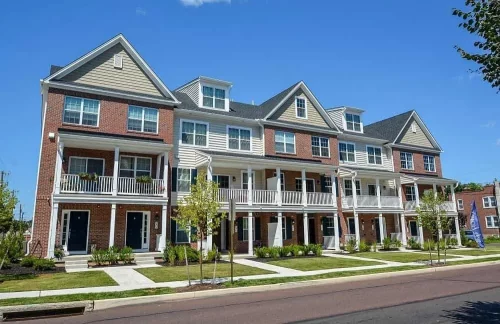Differences in Condo, Townhouse, and Single-Family Home HOAs

Single-family residences, condos, and townhomes are all great home options, but they’re unique in their own ways. When considering which home is the right fit for you, it’s important to be aware of how these homes differ, including within their homeowner associations (HOAs).
“The only difference is what has to be maintained by the homeowner and the HOA,” says Jeff Benach, co-principal at Lexington Homes in Chicago, Illinois. “For a condo, for example, everything is covered — the HOA handles the insurance and generally the building maintenance.”
Alyssa H. Solarsh, Esq., and Melissa B. Schlactus, Esq.—both of Taylor, Eldridge, & Endres, P.C., in Smithtown, New York—say owners living in an attached home type typically have less maintenance responsibilities than those living in a single-family home community.
“For example, the board of a condominium or HOA will generally be responsible for roof and siding repairs to homes in attached-home communities,” Solarsh and Schlatus explain, “whereas an owner of a single-family may be responsible for repairs to his or her own roof and siding. As a result, monthly common charges or assessments are generally higher in attached-home communities.”
It’s important to note that the difference between a single-family residence HOA and a condo or townhome HOA has nothing to do with fees; rather, the fees will vary based on what each HOA covers and which amenities they offer. Because there’s less maintenance required, a condo or townhome may be more conducive to a leave-and-lock lifestyle for busy or traveling homeowners.
How Are These HOAs Similar?
HOAs for all home types have the same goal: to safeguard homeowners’ assets.
While HOAs often get a bad rap, they play a vital role in helping to keep neighborhoods and buildings maintained, as well as protecting property values, says Natalia Paulino, a licensed real estate salesperson with Keller Williams Realty in Brooklyn, New York.
“The rules and guidelines maintaining your property are likely to increase the appreciation of your home’s value versus a neighborhood with no strict rules that allows homeowners to depreciate the value of home prices by not keeping up with even simple home maintenance,” she says.
Solarsh and Schlatus explain that an HOA board, regardless of whether homes are single-family or attached, will typically control the type of materials used (say, for a siding repair) and the color of materials used in a repair or when simply painting a home to allow for a uniform look within the community.
Paulino adds that there is no one-fee-fits-all model — with more amenities and services come higher HOA fees, so it’s important to understand what those fees do and do not cover before purchasing a home in a community or building that has an HOA. Amongst other important steps when moving into a new home, be sure to request a copy of all the HOA’s governing documents.
How Are These HOAs Different?
Single-family residence HOAs generally cover common areas such as neighborhood parks, green spaces, sidewalks, and swimming pools. Homeowners are responsible for their own home and yard maintenance.
“In condo associations, each homeowner owns their unit, taking a share of the building and the building’s common areas,” says Paulino, adding that townhomes typically split fees based on the proportion to their share on a lot.
The difference between a single-family residence HOA and a condo or townhome HOA is that condo or townhome owners are responsible for their unit inside a building. Condo or townhome HOA fees typically cover insurance and the shell of the building, as well as common areas and landscaping maintenance.
What Does HOA Cover for Townhouse and Condos?
Let’s say that, for example, a condo building needs a new roof. All the owners in the building are responsible for their share of the roof repair — in essence, the fees they pay into an HOA will cover their portion, rather than just one person being on the hook for the entire repair fee, as would happen with a single-family residence.
So, when trying to decide which home type is right for you, consider how much of the maintenance you would like to manage financially.
In some single-family residence neighborhoods, HOAs don’t exist or don’t play a big role in homeowners’ daily lives. However, it’s hard to imagine a condo or townhome building without an HOA, says Benach. That’s because someone must be responsible for building maintenance.
“A condo or townhome building that doesn’t have an HOA is a disaster waiting to happen,” he says. “If there’s an issue that affects a neighbor, there would be nobody to make sure there’s even or equal ‘rights’ for every condo or townhome owner.”
The difference between a condo or townhome HOA and a single-family residence comes down to who is responsible for different types of maintenance. If you prefer a home that requires little maintenance on your part, a condo or townhome may be the right option for you.
If you prefer to handle more of the maintenance on your home, a single-family residence may be a better option. Before making your new home purchase, compare the HOA covenants from all housing types so you’ll know what is expected of homeowners in each neighborhood.
See more at…https://www.newhomesource.com/learn/differences-in-hoa-policies/